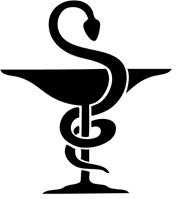 Merriam-Webster defines secundum artem as "according to the accepted practice of a profession or trade". In pharmacy it typically goes hand in hand with the preparation of extemporaneous compounds, i.e. when you have to make something from scratch. Pharmacists have been doing this since the profession began. Unfortunately it’s a dying art not only because of lack of interest from younger pharmacists, but secondary to increased regulation and bureaucratic red tape as well. It’s a real shame. To put it in perspective it would be like surgeons no longer performing surgery by hand because of the invention of the da Vinci Robot.
Merriam-Webster defines secundum artem as "according to the accepted practice of a profession or trade". In pharmacy it typically goes hand in hand with the preparation of extemporaneous compounds, i.e. when you have to make something from scratch. Pharmacists have been doing this since the profession began. Unfortunately it’s a dying art not only because of lack of interest from younger pharmacists, but secondary to increased regulation and bureaucratic red tape as well. It’s a real shame. To put it in perspective it would be like surgeons no longer performing surgery by hand because of the invention of the da Vinci Robot.
Tag: Pharmacy Practice
-
Secundum artem. Yeah, not so much
-
Technology in the IV room – its time has come
The cleanroom environment, a.k.a. the IV room, is one of my favorite areas inside an acute care pharmacy. It is often alive with activity, and can often be the busiest area of the pharmacy. It is also a unique place since the use of intravenous (IV) medications is vital to the successful outcomes of patients, but at the same time can result in some of the most egregious errors in healthcare. While the IV compounding process is under tight control as demanded by USP guidelines, the method of preparation and distribution is decidedly more conventional, i.e. IV rooms often rely heavily on humans. It’s an interesting dichotomy found nowhere else in the pharmacy. It is for these reasons that I find it interesting that pharmacy IV rooms have lagged behind other areas of pharmacy operations in automation and technology. However, that’s beginning to change.
-
Model for scheduling complex medication regimens
The abstract below caught my attention. I can’t read the entire article because I don’t have a subscription to the journal (a pet peeve of mine – just sayin’). Nonetheless I found the abstract quite interesting. I think the conclusion is a bit overly optimistic, but the use of computers to calculate an optimized medication schedule for individual patients is a promising idea. (Comput Methods Programs Biomed. 2011 Dec;104(3):514-9. Epub 2011 Oct 5.)
Abstract
Medication adherence tends to affect the recovery of patients. Patients having poor medication adherence show a worsening of their condition and/or increased complications. Unfortunately, between 20% and 50% of chronic patients are unable to manage their medications. This study proposes a model to improve the patients’ medication compliance by reducing medication frequency.Published studies have shown that, based on the patients’ lifestyle, simplification of the medication frequency and remodeling of the medication schedule is able to help improve medication adherence. Therefore, this study tried to simplify medication frequency by combining therapies. Moreover, by adjusting according to lifestyle, the study also tries to remodel medication timing in relation to mealtimes to create personal medication schedules.
In this study, we used 19,393,452 outpatient prescriptions from the National Health Insurance Research Database to verify our system (algorithm optimized). At the same time, we examined the differences between the frequency summarized by general public and experts’ advice medication behavior. Compared with the experts’ advice method, this system has reduced the medication frequency in about 49% of prescriptions.
Using combined medication to simplify medication frequency is able to reduce the medication frequency significantly and improve medication adherence. Furthermore, this should also improve patient recovery, reduce drug hazards and result in less drug wastage.
-
Webinar: Effective Pharmacy Interactions with ‘The C-Suite’
I think a key for the future of pharmacy will be for pharmacy leaders to learn how to engage the C-Suite within their own healthcare system. That makes the content of this webinar from Pharmacy OneSource particularly interesting.
Wednesday, December 14th: "Effective Pharmacy Interactions with ‘The C-Suite’"
Jim Jorgenson, RPh, MS, FASHPReserve your Webinar seat now at:
https://www2.gotomeeting.com/register/340160290
Jim Jorgenson, Chief Pharmacy Officer and Vice President of Indiana University Health, will provide the pharmacist with background information about the current healthcare environment, with an emphasis on how the hospital/health-system and priorities of the C-Suite are affected. The overall goal is to enable the pharmacist to gain knowledge and confidence in preparation to present to the C-Suite on topics affecting pharmacy and the medication use process. Specific case examples of presentations that worked and did not work will be provided.
Effective Pharmacy Interactions with ‘The C-Suite’
Date: Wednesday, December 14, 2011
Time: 12:00 PM – 1:00 PM ET
Register: https://www2.gotomeeting.com/register/340160290 -
Pharmacists impact on osteoporosis management (review article)
Pharmacists are pretty good at helping people with chronic medical conditions manage their medications, hence the term Medication Therapy Managment (MTM). You can find more information about MTM at the American Pharmacists Association (APhA) website.
Anyway, I came across an article this morning that gives the results of a literature review “to examine the impact of pharmacist interventions in improving osteoporosis management“. While I’m not a big fan of review articles in general because the information can be skewed, I found the conclusion to my liking. The articles concludes that “[d]ata support the potential role for pharmacists to help reduce gaps in osteoporosis management through improved identification of high-risk patients.” And then the article goes on to say that more research is needed. I personally think it’s time to move beyond the research stage and start integrating MTM into the care of all patients. It should be the standard.
.
-
What do pharmacists want?
 It’s a simple question with a simple answer. In today’s pharmacy environment pharmacists want to do more “clinical†activities and distance themselves from the physical pharmacy. See, I told you it was simple.
It’s a simple question with a simple answer. In today’s pharmacy environment pharmacists want to do more “clinical†activities and distance themselves from the physical pharmacy. See, I told you it was simple.For the last several months I’ve been listening to people tell me what pharmacists, and pharmacies, want. I find it interesting that most of the opinions differ from mine. No big deal as opinions are opinions, remember? But today I had a brief, albeit passionate discussion over what pharmacists want. The people telling me what pharmacists wanted weren’t healthcare professionals. They were engineers, sales people, etc. I know that comes off a bit elitist, but it’s not. I don’t pretend to know what an engineer knows, so perhaps they shouldn’t pretend to know what I know. Fair? I think so.
-
Why regulatory compliance is killing innovation in healthcare
Anyone that’s worked in healthcare knows about regulatory compliance. If not, then they should because it takes up about 50% of everyone’s time, energy and effort. I understand the theory behind regulations, i.e. protect the patient, but I think most of the time all additional regulations do is is create work for people that are already over burdened.
Ask a nurse how much time they spend documenting and double documenting things to meet some arbitrary rule or regulation. You’ll be surprised by the answer. Now ask a pharmacist or a physician. You’ll get the same ugly responses. I know a lot of my time as a clinician was spent generating documentation to cover my ass rather than helping care for a patient.
Unfortunately the need to comply with government agencies and silly rules inside the walls of healthcare has generated an unwanted side effect – lack of innovation. Why? Because all that innovative energy is spent on regulatory compliance instead of other, more useful things.
I’ve been involved in several conversations over the last month dealing with how to best use pharmacy automation and technology to increase efficiency and solve problems. Would you like to venture a guess as to what most of those conversations centered on? Yep, how to automate some documentation process or create technology to meet some new regulatory compliance. None of the discussions have been about providing better, safer, more complete patient care.
If you don’t think this is a major problem, think again. I was reading a blog by John Halamka last night in which he discusses the ‘Burden of Compliance’. In the blog John states that “[a]s we draft new regulations that impact healthcare IT organizations, we need to keep in mind that every regulation has a cost in dollars, time, and complexity.†Just remember, there is a finite amount of dollars and time floating around in healthcare these days. If a majority of those dollars and time are gobbled up by regulatory compliance, what does that leave for innovation to actually improve medication distribution, safe administration and better patient care? Precious little if you ask me.
-
Cool Technology for Pharmacy – PharmASSIST OPTIx
ThomasNet News: “PharmASSIST OPTIx enables remote prescription verification by taking a high-resolution image of each prescription’s vial contents and vial label, and automatically displaying them on a designated pharmacist’s workstation. The pharmacist compares these images to the appropriate drug image from a standardized drug database, along with specific prescription details to complete the verification. The verifying pharmacist can be stationed anywhere – in the front of the pharmacy counseling patients or offsite at another pharmacy, a central processing center, or working from a home office. PharmASSIST OPTIx stores each prescription’s images as part of the patient history record, enabling pharmacies to quickly retrieve them for pharmacy benefit manager (PBM) audits and to confirm the quantity dispensed.
Pharmacies can use PharmASSIST OPTIx in stand-alone mode or integrated with Innovation’s PharmASSIST Symphony® workflow systems, which enables end-to-end prescription tracking, problem management, and reporting. In addition to processing a pharmacy’s countable medications, PharmASSIST OPTIx handles all non-countable products (e.g., ointments/creams, liquids, syringes, inhalers, etc.) for prescription filling and remote verification. The system can also assist pharmacies with physical inventory control.â€
It reminds me of a non-cleanroom version of DoseEdge.
Additional automation is needed for it to be a real game changer, but it’s still pretty cool technology. It would be slick if the person filling the prescription never had to touch the product and the end result could be remotely verified.
Product website here.
OPTIx brochure (PDF).
-
Drug shortages, the self-fulfilling prophecy
It seems that every pharmacy I visit lately has an excess of certain medications bursting from their shelves. It’s a strange thing as discussions involving inventory tend to focus on reduction, not accumulation.
I’ve seen boxes of enoxaparin, midazolam and propofol stacked to the ceiling in pharmacies throughout various parts of the country. When I inquire about the reasons behind the large quantities I typically get one of the following responses: “it’s on backorder so we ordered as much as we could get†or “it was hard to get so we ordered extraâ€.
Drug shortages have become quite a problem over the past year. ASHP has dedicated significant time and resources to the issue. They’ve even gone as far as establishing a website where you can go for the most up to date information. In addition they’re calling for action to help support the Preserving Access to Life Saving Medications Act.
With that said I think part of the problem is pharmacies over ordering medications on backorder, thus contributing to the shortage. Think about it. Reminds me of the Eric Cartman novel marketing strategy, dubbed the "you-can’t-come" technique. Tell people they can’t have something and the go crazy trying to get it.
There are reasonable alternatives to many of the medications on the drug shortage list. It’s a real shame to see pharmacies not utilizing a better strategy.